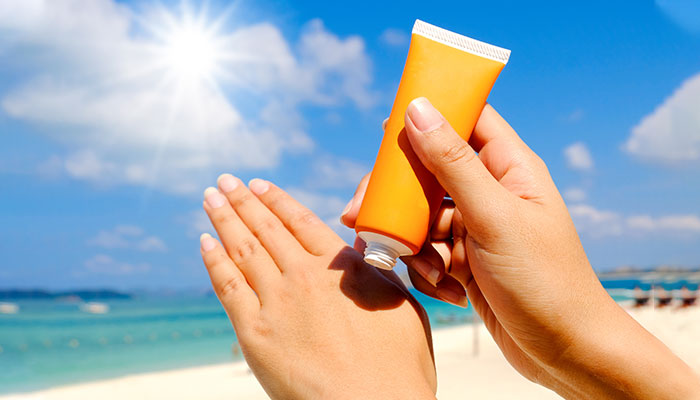In communities of color, it is widely believed that black and brown people do not need sunscreen. Dermatologists say this isn’t true, and people of color should make sunscreen a part of their daily routines. Doctors say dark-skinned people should use broad-spectrum sunscreen or products with SPF 30 or higher.
It’s a common belief among black and brown community members: they don’t have to wear sunscreen, and they don’t get burned by the sun.
Dr. Mona Gohara, a dermatologist at Dermatology Physicians of Connecticut and associate clinical professor at Yale University’s School of Medicine, says the beliefs go back to the “old school mindset” that sunscreen only protects against sunburn, sunburn, and skin cancer and that black and brown people cannot burn, tan or get skin cancer.
“None of those things are true,” she says. “We can burn. We can tan, and we can get skin cancer.”

She and other dermatologists oppose these claims, instead encouraging dark-skinned people to use sunscreen.
Skincare Hacks: Banana Peels For Your Skin? Experts weigh in on the viral TikTok skincare regimen.
More About SPF: Hugh Jackman Reveals Skin Biopsy, Jesse Tyler Ferguson Had Skin Cancer: What You Need To Know About SPF
Gohara says many people of color don’t realize the power of sunscreen.
Sunscreen protects the skin from excessive sunlight, but it also helps against aging, acne scars, and dark spot and protects against visible or blue light, she says. Such light comes from computer monitors, cell phones, and light bulbs.
This visible light, Gohara says, can lead to a condition called melasma, a blotchy, brownish discoloration on the face — a condition that’s more common in black and brown people. Melasma is more common in black and brown people because they produce more melanin, the pigmentation that gives the skin its tan.
“Melasma is a response that occurs when melanin interacts with a type of light,” says Gohara. “The more melanin you have, the more likely you will get it.”
Melasma usually occurs on the cheeks, says Dr. Henry Lim, senior vice president for academic affairs at the Henry Ford Health System in Michigan. Some people even develop melasma around their eyes.
But melasma isn’t the only condition people of color are at risk for if they don’t use sunscreen. There’s also post-inflammatory hyperpigmentation, or discoloration, that occurs after pimples, Gohara says.
“(Post-inflammatory hyperpigmentation) is much more common in us because our melanin goes into overdrive,” says Gohara. “If we don’t wear sunscreen, we can get hyperpigmentation and brown spots that can last for a long time.”
Melanin, she says, is a pigment produced in the top layer of skin, the epidermis; In addition to giving the skin its tan, it also protects against ultraviolet light from the sun’s rays.
“A medium brown person probably has a God-given melanin sun protection factor of about 13 versus a white person, (who) would have about a 3,” says Gohara.
Safe sunscreen: Is your sunscreen ‘safe’? What you need to know about protecting yourself from the sun this summer
SPF Options: Update your SPF throughout the day with these powder sunscreens
Best practices for people with melanoma skin
dr. Lim of the Henry Ford Health System says dark-skinned people don’t burn as easily as fair-skinned people, so their sunscreen doesn’t have to have such a high sun protection factor (SPF). He recommends SPF 30 for dark-skinned people and SPF 50 for lighter-skinned people.
Lim said the natural skin pigmentation — melanin — in dark-skinned people “provides significant protection against skin cancer.” Hence, skin cancer cases are much lower in dark-skinned people than in fair-skinned people.
But because dark-skinned people are more likely to experience pigmentation changes than fair-skinned people, industry experts recommend sunscreen with good broad-spectrum protection.
Broad-spectrum sunscreen protects against ultraviolet light and reduces the chance of “pigmentation change,” says Lim.
Most importantly, he says, good skincare is a package deal, and sunscreen is just one part. Those who go out into the sun should wear sunscreen, wide-brimmed hats, protective clothing, and sunglasses.
Application is also important, according to Gohara.
While some brands already offer moisturizers with sunscreen, she suggests that people apply a regular moisturizer first and then put sunscreen on it, and should do it every day.
“I keep my sunscreen next to my toothbrush in the morning,” she says. “It reminds me to apply it.”
Whether indoors or out, people should use a nickel-sized amount of sunscreen to protect their faces.
“When you’re outdoors, we recommend reapplying every few hours or after excessive swimming or sweating,” she says.
Sunscreens for people of color
While previous sunscreens have typically been chalky, white, and not ideal for people of color, the industry has “done a good job of recognizing the long-awaited need that everyone should wear sunscreen and create better shades,” says Gohara.
One brand she recommends is EltaMD because some of their products contain niacinamide, an active ingredient to reduce acne and inflammation.
Dr. Janine Luke, director of the residency program in the Department of Dermatology at Loma Linda University in California, says there are several types of sunscreen that people of color can choose from. Two main types of sunscreens are chemical and physical (mineral) sunscreens.
Physical or mineral sunscreen usually acts as a shield, deflecting or scattering ultraviolet rays, Luke says. Once the mineral sunscreen is applied, it sits on the skin’s surface.
As for chemicals, “Chemical sunscreens act like a sponge, absorbing UV rays and converting them into heat that is then released through the skin,” Luke says.
She uses both types and provides recommendations for those seeking sun protection, including:
“We’re sensitive to the effects of the sun,” Luke says. “We can get skin cancer, and sometimes it’s in areas that aren’t exposed to the sun. It’s something we need to keep on our radar.”
Saleen Martin is a reporter for USA TODAY’s NOW team. She is from Norfolk, Virginia, and loves horror, witches, Christmas, and food.
Saleen Martin, [email protected], Twitter: @Saleen_Martin





